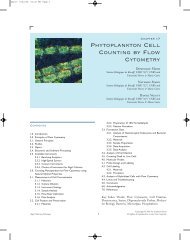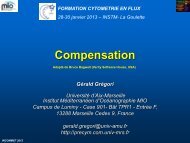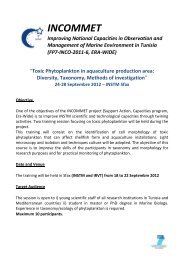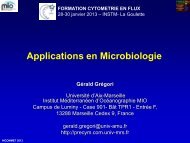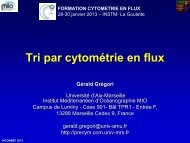Eukaryotic Picoplankton in Surface Oceans - incommet
Eukaryotic Picoplankton in Surface Oceans - incommet
Eukaryotic Picoplankton in Surface Oceans - incommet
Create successful ePaper yourself
Turn your PDF publications into a flip-book with our unique Google optimized e-Paper software.
Annu. Rev. Microbiol. 2011.65:91-110. Downloaded from www.annualreviews.org<br />
by CSIC - Consejo Superior de Investigaciones Cientificas on 09/27/11. For personal use only.<br />
bacterial grazers (39). The recent molecular<br />
revolution has shown that the eukaryotic picoplankton<br />
<strong>in</strong>cludes a large phylogenetic diversity<br />
and many novel l<strong>in</strong>eages (22, 55, 82).<br />
Molecular methods today offer new tools for<br />
study<strong>in</strong>g picoplankton biogeography, activity,<br />
biological <strong>in</strong>teractions, and population control<br />
mechanisms.<br />
This review focuses on the eukaryotic<br />
picoplankton liv<strong>in</strong>g <strong>in</strong> the region where photosynthesis<br />
occurs (upper 200 m), because this<br />
reactive surface sk<strong>in</strong> harbors the largest variety<br />
of taxa and functional modes. This review does<br />
not address the dark ocean, a biome with its<br />
own biogeochemical properties (5), nor does<br />
it address anoxic systems or lakes typically<br />
harbor<strong>in</strong>g a different microbial life (43, 79).<br />
Picoeukaryotes are considered cells ≤3 μm,<br />
a criterion widely used (82) and supported by<br />
direct observations. The ecology of mar<strong>in</strong>e<br />
picoeukaryotes treated as a bulk assemblage is<br />
presented first. Then, tools for open<strong>in</strong>g this<br />
black box are listed, followed by navigation<br />
through the ma<strong>in</strong> phylogenetic groups and<br />
their putative cell abundance and ecological<br />
roles. F<strong>in</strong>ally, population and community<br />
ecology issues deserv<strong>in</strong>g more attention are<br />
discussed.<br />
BULK ECOLOGICAL ROLE<br />
Distribution and Cell Abundance<br />
The smallest eukaryotes were first quantified<br />
by epifluorescence microscopy (23, 37) and<br />
separated between chloroplast-conta<strong>in</strong><strong>in</strong>g<br />
phototrophs and colorless heterotrophs<br />
(Figure 1c–g). These cells, often flagellated,<br />
were considered nanoflagellates. Flow cytometry,<br />
soon used to quantify phytoplankton<br />
(62), yielded phototrophic eukaryotic counts<br />
(named picoeukaryotes) roughly equivalent<br />
to epifluorescence counts of phototrophic<br />
nanoflagellates. Typical abundances by both<br />
methods are 1–3 × 10 3 cells ml −1 <strong>in</strong> oligotrophic<br />
systems and up to 10 5 cells ml −1<br />
<strong>in</strong> coastal and nutrient-rich regions (47, 72).<br />
With<strong>in</strong> the water column, counts <strong>in</strong>crease<br />
a<br />
c 1<br />
d 1<br />
e 1<br />
h<br />
Figure 1<br />
c 2<br />
d 2<br />
e 2<br />
3 μm<br />
i<br />
b<br />
3 μm<br />
f<br />
g<br />
3 μm<br />
Mar<strong>in</strong>e picoeukaryotes as seen by (a,b) light microscopy, (c–g) epifluorescence<br />
microscopy, and (h,i ) scann<strong>in</strong>g electron microscopy. Epifluorescence<br />
images are taken by UV excitation for (c 1 -e 1 , f,g) DAPI-sta<strong>in</strong>ed DNA blue<br />
fluorescence or by blue excitation for (c 2 -e 2 )Chla red autofluorescence.<br />
Organisms are (a) Pelagomonas calceolata; (b) Micromonas pusilla; two<br />
unidentified phototrophic picoeukaryotes, probably (c) a pras<strong>in</strong>ophyte<br />
and (d ) a haptophyte; (e) an unidentified heterotrophic picoeukaryote;<br />
and ( f–i ) unidentified cells. Images courtesy of I. Forn,<br />
A.M. Cabello, J. del Campo, and J.M. Fortuño. Abbreviation:<br />
DAPI, 4 ′ ,6-diamid<strong>in</strong>o-2-phenyl<strong>in</strong>dole.<br />
www.annualreviews.org • Mar<strong>in</strong>e Picoeukaryotes 93



